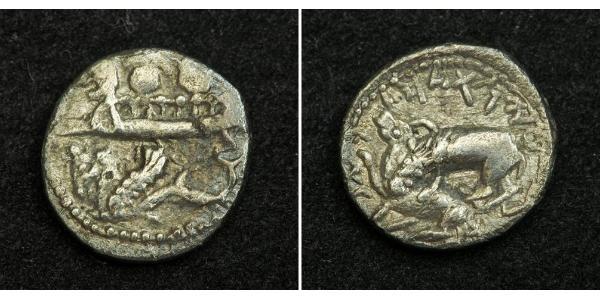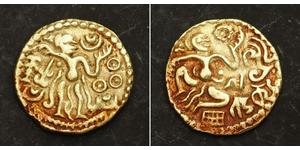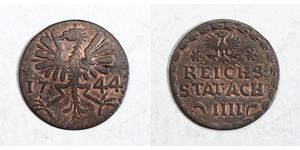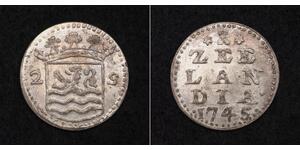(售价 $123.0)
Phoenicia, Byblos (ca. 333 BC) AR 1/16 Stater (1/8th Shekel) Coin. Tiny & Rare!
Mint Place: Ainel
Mint Period: ca. 330 BC
Region: Phoenicia, Byblos
Reference: BMC 8-9, pl. XII, 2. Rare!
Condition: VF+ (minor deposits) / aXF!
Denomination: AR 1/16 Stater (1/8 Shekel)
Diameter: 10mm
Weight: 0.74gm
Material: Silver
Obverse: Galley left, containing two hoplites with helmets and round shields, hippocamp below left.
Reverse: Lion attacking bull left, Phoenician inscription above. Inscription above.
Phoenicia was an ancient Semitic civilization situated on the western, coastal part of the Fertile Crescent and centered on the coastline of modern Lebanon and Tartus Governorate in Syria. All major Phoenician cities were on the coastline of the Mediterranean, some colonies reaching the Western Mediterranean. It was an enterprising maritime trading culture that spread across the Mediterranean from 1550 BC to 300 BC. The Phoenicians used the galley, a man-powered sailing vessel, and are credited with the invention of the bireme. They were famed in Classical Greece and Rome as 'traders in purple', referring to their monopoly on the precious purple dye of the Murex snail, used, among other things, for royal clothing, and for their spread of the alphabet (or abjad), from which almost all modern phonetic alphabets are derived.
Phoenicians are widely thought to have originated from the earlier Canaanite inhabitants of the region. Although Egyptian seafaring expeditions had already been made to Byblos to bring back "cedars of Lebanon" as early as the 3rd millennium BC, continuous contact only occurred in the Egyptian New Empire period. In the Amarna tablets of the 14th century BC, people from the region called themselves Kenaani or Kinaani (either the same as the Canaanites, or the Kenanites/Cainanites spoken of the Septuagint version of Gen. 10:24), although these letters predate the invasion of the Sea Peoples by over a century. Much later, in the 6th century BC, Hecataeus of Miletus writes that Phoenicia was formerly called χνα (Latinized: khna), a name Philo of Byblos later adopted into his mythology as his eponym for the Phoenicians: "Khna who was afterwards called Phoinix".
Phoenicia is really a Classical Greek term used to refer to the region of the major Canaanite port towns, and does not correspond exactly to a cultural identity that would have been recognised by the Phoenicians themselves. It is uncertain to what extent the Phoenicians viewed themselves as a single ethnicity and nationality. Their civilization was organized in city-states, similar to ancient Greece. However, in terms of archaeology, language, life style and religion, there is little to set the Phoenicians apart as markedly different from other Semitic cultures of Canaan. As Canaanites, they were unique in their remarkable seafaring achievements.
Each city-state was a politically independent unit. They could come into conflict and one city might be dominated by another city-state, although they would collaborate in leagues or alliances. Though ancient boundaries of such city-centered cultures fluctuated, the city of Tyre seems to have been the southernmost. Sarepta (modern day Sarafand) between Sidon and Tyre is the most thoroughly excavated city of the Phoenician homeland.
The Phoenicians were the first state-level society to make extensive use of the alphabet. The Phoenician phonetic alphabet is generally believed to be the ancestor of almost all modern alphabets, although it did not contain any vowels (these were added later by the Greeks). From a traditional linguistic perspective, they spoke Phoenician, a Canaanite dialect. However, due to the very slight differences in language, and the insufficient records of the time, whether Phoenician formed a separate and united dialect, or was merely a superficially defined part of a broader language continuum, is unclear. Through their maritime trade, the Phoenicians spread the use of the alphabet to North Africa and Europe, where it was adopted by the Greeks, who later passed it on to the Etruscans, who in turn transmitted it to the Romans. In addition to their many inscriptions, the Phoenicians are believed to have left numerous other types of written sources, but most have not survived.
Byblos, in Arabic Jubayl, is a Mediterranean city in the Mount Lebanon Governorate, Lebanon. It is believed to have been occupied first between 8800 and 7000 BC, and according to fragments attributed to the semi-legendary pre-Trojan War Phoenician historian Sanchuniathon, it was built by Cronus as the first city in Phoenicia. Today it is believed to be the oldest continuously-inhabited city in the world.
1 Penny 英国 銀 爱德华七世 (1841-1910)
本组有 5 钱币 / 5 售价
⇑

























